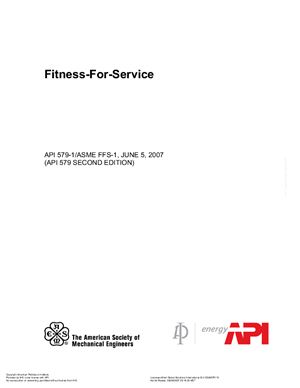1128 стр.
American Petroleum Institute, The American Society of Mechanical Engineers, JUNE 5, 2007, Second Edition
The methods and procedures in this Standard are intended to supplement and augment the requirements in API 510, API 570, API 653, and other post construction codes that reference FFS evaluations such as NB-23.
The assessment procedures in this Standard can be used for Fitness-For-Service assessments and/or rerating of equipment designed and constructed to the following codes
a) ASME B&PV Code, Section VIII, Division 1
b) ASME B&PV Code, Section VIII, Division 2
c) ASME B&PV Code, Section I
d) ASME B31.1 Piping Code
e) ASME B31.3 Piping Code
f) API 650
g) API 620
The assessment procedures in this Standard may also be applied to pressure containing equipment constructed to other recognized codes and standards, including inteational and inteal corporate standards. This Standard has broad application since the assessment procedures are based on allowable stress methods and plastic collapse loads for non-crack-like flaws, and the Failure Assessment Diagram (FAD) Approach for crack-like flaws (see Part 2 , paragraph 2.4.2).
a) If the procedures of this Standard are applied to pressure containing equipment not constructed to the codes listed in paragraph 1.2.2, then the user is advised to first review the validation discussion in Annex H. The information in Annex H, along with knowledge of the differences in design codes, should enable the user to factor, scale, or adjust the acceptance limits of this Standard such that equivalent FFS inservice margins can be attained for equipment not constructed to these codes. When evaluating other codes and standards the following attributes of the ASME and API design codes should be considered:
1) Material specifications
2) Upper and/or lower temperature limits for specific materials
3) Material strength properties and the design allowable stress basis
4) Material fracture toughness requirements
5) Design rules for shell sections
6) Design rules for shell discontinuities such as nozzles and conical transitions
7) Design requirements for cyclic loads
8) Design requirements for operation in the creep range
9) Weld joint efficiency or quality factors
10) Fabrication details and quality of workmanship
11) Inspection requirements, particularly for welded joints
b) As an alteative, users may elect to correlate the pressure-containing component’s material specification to an equivalent ASME or API listed material specification to determine a comparable allowable stress. This approach provides an entry point into the ASME or API codes (refer also to Annex A) wherein the pressure-containing component is reconciled or generally made equivalent to the design bases assumed for this Standard. Hence, general equivalence is established and the user may then directly apply the acceptance limits of the Fitness-For-Service procedures contained in this Standard. Equivalent ASME and ASTM material specifications provide a satisfactory means for initiating reconciliation between the ASME and API design codes and other codes and standards. However, the user is cautioned to also consider the effects of fabrication and inspection requirements on the design basis (e.g., joint efficiency with respect to minimum thickness calculation).
American Petroleum Institute, The American Society of Mechanical Engineers, JUNE 5, 2007, Second Edition
The methods and procedures in this Standard are intended to supplement and augment the requirements in API 510, API 570, API 653, and other post construction codes that reference FFS evaluations such as NB-23.
The assessment procedures in this Standard can be used for Fitness-For-Service assessments and/or rerating of equipment designed and constructed to the following codes
a) ASME B&PV Code, Section VIII, Division 1
b) ASME B&PV Code, Section VIII, Division 2
c) ASME B&PV Code, Section I
d) ASME B31.1 Piping Code
e) ASME B31.3 Piping Code
f) API 650
g) API 620
The assessment procedures in this Standard may also be applied to pressure containing equipment constructed to other recognized codes and standards, including inteational and inteal corporate standards. This Standard has broad application since the assessment procedures are based on allowable stress methods and plastic collapse loads for non-crack-like flaws, and the Failure Assessment Diagram (FAD) Approach for crack-like flaws (see Part 2 , paragraph 2.4.2).
a) If the procedures of this Standard are applied to pressure containing equipment not constructed to the codes listed in paragraph 1.2.2, then the user is advised to first review the validation discussion in Annex H. The information in Annex H, along with knowledge of the differences in design codes, should enable the user to factor, scale, or adjust the acceptance limits of this Standard such that equivalent FFS inservice margins can be attained for equipment not constructed to these codes. When evaluating other codes and standards the following attributes of the ASME and API design codes should be considered:
1) Material specifications
2) Upper and/or lower temperature limits for specific materials
3) Material strength properties and the design allowable stress basis
4) Material fracture toughness requirements
5) Design rules for shell sections
6) Design rules for shell discontinuities such as nozzles and conical transitions
7) Design requirements for cyclic loads
8) Design requirements for operation in the creep range
9) Weld joint efficiency or quality factors
10) Fabrication details and quality of workmanship
11) Inspection requirements, particularly for welded joints
b) As an alteative, users may elect to correlate the pressure-containing component’s material specification to an equivalent ASME or API listed material specification to determine a comparable allowable stress. This approach provides an entry point into the ASME or API codes (refer also to Annex A) wherein the pressure-containing component is reconciled or generally made equivalent to the design bases assumed for this Standard. Hence, general equivalence is established and the user may then directly apply the acceptance limits of the Fitness-For-Service procedures contained in this Standard. Equivalent ASME and ASTM material specifications provide a satisfactory means for initiating reconciliation between the ASME and API design codes and other codes and standards. However, the user is cautioned to also consider the effects of fabrication and inspection requirements on the design basis (e.g., joint efficiency with respect to minimum thickness calculation).

